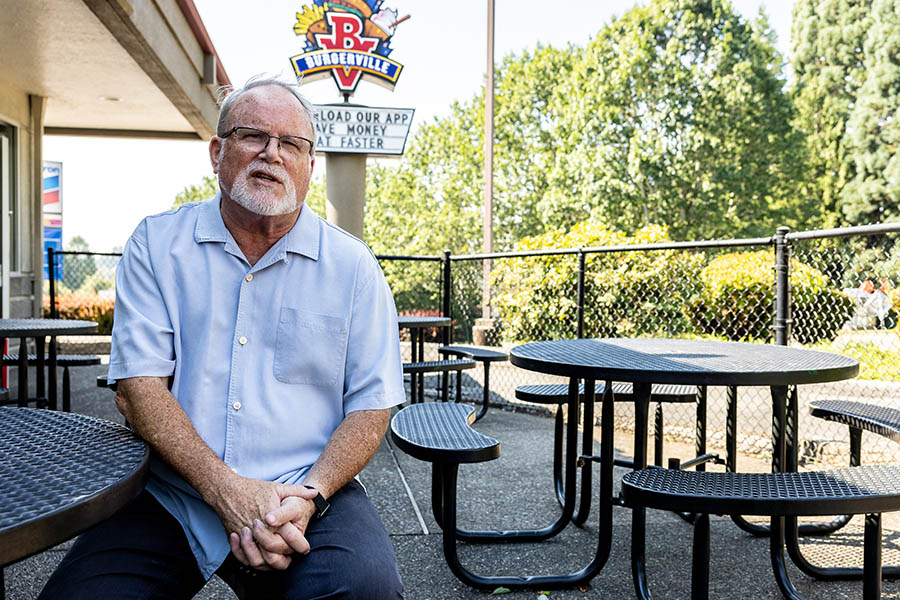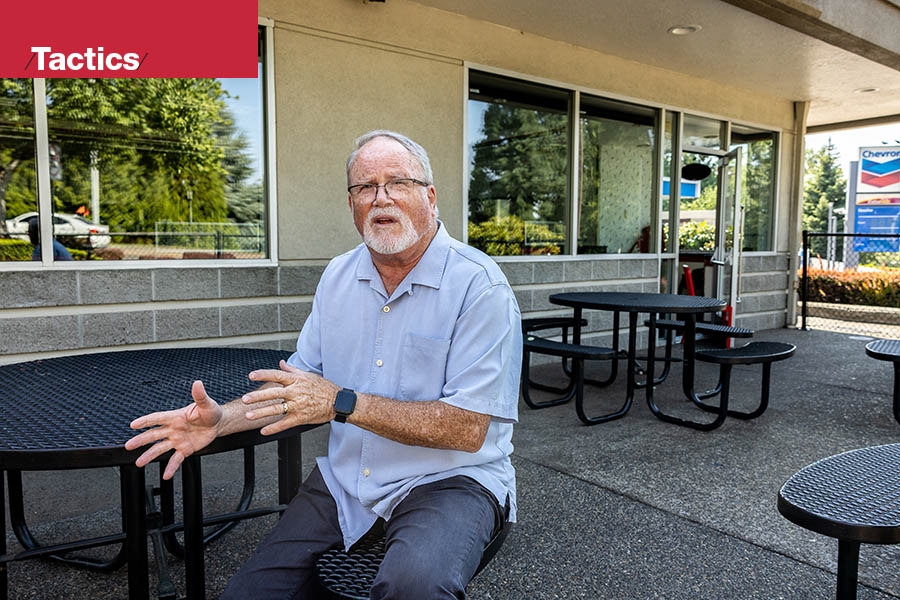Burgerville’s CEO talks about improving service and sales — and bringing back much-loved menu items — at the popular fast-food chain
Ed Casey stepped into his role as Burgerville’s CEO in February following the departure of Jill Taylor, who led the company for more than five years. Casey is a restaurant-industry veteran, starting his career at TGI Fridays, where he worked as VP of operations until 1989. After moving to the Northwest, he opened the first Applebee’s franchise in the Northwest, and also ran several Baja Fresh locations in the Northwest as a franchisee.
In 2011 Casey and his wife opened the downtown Portland restaurant and catering company Cheryl’s on 12th. The plan was to get away from chain restaurants, but then the opportunity to take the reins at Burgerville opened up, and Casey rose to the occasion: “I just love it. It’s such a great, iconic brand.”
Casey came to Burgerville at a tumultuous time for the chain, which is owned by Vancouver-based restaurant group The Holland, Inc. Two months before he joined the company, workers at five locations voted to ratify their first labor contract, a move that followed three years of negotiations and makes them the first fast-food workers in the country to be covered by a collective bargaining agreement.
He spoke to Oregon Business in September about that shift, as well as the effects of COVID-19 on the company — and about how he’s working to improve sales and shake up the menu.
This interview has been edited for length and clarity.
How have your first six months on the job been?
They’ve been great. All of the things that happened in the last couple of years were pretty rough on the company. When I came onboard at the end of January, none of the dining rooms were open — they were drive-thru only. They had some real staffing challenges, and we still are struggling with the staffing; that’s kind of a universal problem everywhere. But I think we’re kind of up to the point at least where we’re in as good or better shape than most we brought on. Now we’re net positive about 500 employees, almost over 400 employees from the time that I came onboard. We’ve done pretty good with that.
From the moment I came onboard, I started getting texts and emails from old associates and from people I don’t even know, saying, “Hey, please bring back the sweet potato French fries” or the triple-berry shake — whatever items were their favorites that have been discontinued or not around for a while. We spent a lot of time kind of focusing on menu development and what those old favorites were. We’ve reintroduced some of those as well, and have just focused on the food quality and the speed of service — all the things that have made Burgerville successful over the years. We’ve had some very great results. It’s been a lot of fun.
 CEO Ed Casey outside Burgerville in Southeast Portland. Photo: Jason E. Kaplan
CEO Ed Casey outside Burgerville in Southeast Portland. Photo: Jason E. Kaplan
What are some of the menu items that are coming back?
We’ve got fried green beans coming back. We had the strawberry shortcake during the summertime; they hadn’t had it for a number of years. So many people suggested it to me that I went back and did a little research with the crew here. They used to sell them quite a bit. I think they felt it just wasn’t consistent with the menu direction that they were going in at the time, or there were operational issues, but they took it off several years back and have had lots of clamor for it ever since. We had a great run with it through the summer. Going into the fall, we’re going to have the sweet potato fries. We’ll do [fried] asparagus come spring.
Everybody has been dealing with supply-chain issues. Certainly, that has been something that’s affected Burgerville as well. Does the fact that so many of your products are sourced locally help? Or does it create its own set of challenges?
I would say yes to both, it does help quite a bit. And sometimes it does create its own set of challenges. The challenges are more that we really want to stick with our attributes — using food with integrity, food that’s not just locally sourced but antibiotic-free, hormone-free, not frozen beef and all those kinds of things. Making sure that we have enough supply and making sure we have lined up two different alternate sources, to make sure that if we don’t get product from one vendor, we can pivot to another. That’s been the work of this year: just lining up enough redundancy in our supply chain that we have somewhere to go if we have issues. We’ve had to use our executive team to drive around to pick up stuff and redistribute stuff a few times. For the most part, it’s better this year than it was last year. Late last year was probably the low point.
Has the unusual weather this year —the wet spring and the late berry season — had an effect?
It certainly has. We couldn’t get into the fresh Oregon berries this year until later. We had to start the season with the California berries and move to the Oregon berries as soon as they were available. It was a short season and a limited-supply season. We had a little bit of trouble with that. But the rest of the berries, we were able to get in time; we’re just finishing up with the marionberries right now. It was a little bit touch and go, for sure.
You mentioned staffing issues. Are there specific things that Burgerville is doing to address that, or that you’ve learned from the last six months of managing Burgerville during this time?
I would say it’s two things: One is you can’t catch a fish if you don’t have a line in the water. A lot of it is making sure people understand that you’re hiring and that you’re looking for people. We use the different platforms that are available to us. We’re also direct recruiting — going after people who might be interested or people we meet who have the aptitude and the attributes, and the big smiles, and see if we can direct recruit them.
There are lots of tactics, but probably the most important one is keeping the people you do have. We spend a lot of time and energy trying to make sure that we have good communication with our employees — and that we have things in place to keep them motivated, that we’re competitive on the pay scale, of course.
There’s been a large wave of unionization across the service industry since COVID. But Burgerville, of course, had some union drives a little bit before all of that happened. You’ve mentioned that you had not had a lot of contact with the union so far. Is that still the case?
I haven’t really directly interacted with the union. I’m aware of the bargaining agreement and I’ve read through it. All that transpired before I came on-board, so I kind of just inherited that there’s five out of our 39 stores that are represented by a union. It was a little bit of a surprise. Burgerville was actually the only company I know of in the fast-food arena that gave benefits early on. The employees don’t have to pay for those benefits. So we have a lot more long-term employees [than other fast food chains]. They love Burgerville, of course, specifically because we have benefits. We’ve always made sure the pay scale was competitive.
The union is trying to make things better for the employees, and I don’t really see that as a conflict. We want the best for our employees. We also want the best for our customers, and we want to treat the company with what it needs. It’s always about balancing the needs of the guests against the needs of employees and the needs of the company, and making sure everybody is getting the most out of it. It doesn’t have to necessarily be adversarial.
Have sales changed significantly since you’ve been at the helm of the company?
Yes. I don’t want to sound like I’m tooting my own horn, though. The sales have been very receptive. Aside from the things I’ve already mentioned, there’s so much upside potential for this brand. I’ve always loved Burgerville’s commitment to the product quality, their treatment of their employees, what they represent.
I was a customer at Burgerville for a lot of years. I’ve learned over time that with Burgerville, you have to have extra time. We were not meeting the demand for Burgerville out there simply because it just took too long to get through — especially with dining rooms closed. There wasn’t any real magic. We’ve focused on making sure that we are set up and staffed every shift. All those have been opened up full throttle. We’ve gone from being, you know, significantly behind prior-year sales to two record periods in a row here for the company. So we’re very excited about that.
To subscribe to Oregon Business, click here.






